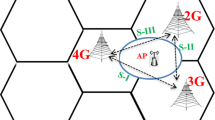Abstract
In future generation mobile cellular systems, position location of mobile terminal is expected to be available. In this paper, we propose an initiation algorithm for intersystem handover based on the combination of position location of mobile terminal and the absolute signal strength thresholds. Global System for Mobile communication (GSM) and Universal Mobile Telecommunication Systems (UMTS) networks are considered for interworking. The proposed algorithm reduces the handover rate by around 50% and thus improves the network resource efficiency as compared to that based on signal strength thresholds only.
Similar content being viewed by others
References
Ahonen, S., & Laitinen, H. (2003). Database correlation method for UMTS location. In proceedings of the IEEE vehicular technology conference, Spring-2003, pp. 2696–2700.
Benson, M., & Thomas, H. J. (2002). Investigation of UMTS to GSM handover procedure. In Proceedings of the IEEE vehicular technology conference, pp. 1829–1833.
Bing, H., He, C., & Jang, L. (2003). Performance analysis of vertical handover in a UMTS-WLAN integrated network. In Proceedings of the IEEE international conference on personal, indoor, and mobile radio communications, pp. 187–191.
Brahmjit, S., Aggarwal, K. K., & Kumar, S. (2003). An analytical model for intersystem handover. In Proceedings of the IEEE TENCON 2003, an international conference on convergent technologies for Asia Pacific Region, Bangalore (India), pp. 1311–1315.
Caffery, J. J., & Stuber, G. L. (1998). Overview of radiolocation in CDMA cellular systems (pp. 38–45). IEEE Communications Magazine.
Chan, P. M. L., Sheriff, R. E., & Hu, Y. F. (2001). An intelligent handover strategy for a multi-segment broadband network. In Proceedings of the IEEE vehicular technology conference, pp. 55–59.
Chen J.-C., Wang Y.-C., Maa C.-S., Chen J.-T. (2006). Network-side mobile location using factor graphs. IEEE Transactions on Wireless Communications 5: 2696–2704
Corazza, G. E., Giancristofaso, D., & Santucci, F. (1994). Characterization of handover initiation in cellular mobile radio networks. In Proceedings of the IEEE vehicular technology conference, pp. 1869–1872.
Dao, D., Rizos, C., & Wang, J. (2002). Location-based services: Technical and business issues. Berlin GPS Solutions, Springer (pp. 169–178).
Drane, C., Macnaughtan, M., & Scott, C. (1998). Positioning GSM telephones. (pp. 46–59). IEEE Communications Magazine.
Durastaute, G., & Zanella, A. (2002). An efficient monitoring strategy for intersystem handover from TD-SCDMA to GSM networks. In Proceedings of the international symposium on personal, indoor and mobile radio communications, pp. 1555–1560.
Gudmundson M. (1991). Correlation model for shadow fading in mobile radio systems. Electronics Letters 27: 2145–2146
Gurtov A., Korhonen J. (2004). Effect of vertical handover on the performance of the TCP-friendly rate control. Mobile Computing and Communications Review 8: 73–87
Juang, R.-T., Lin, H.-P., & Lin, D.-B. An improved location-based handover algorithm for GSM systems. (pp. 1371–1376). IEEE Communication Society WCNC 2005.
Leo M., Luglio M. (2001). Intersegment handover between terrestrial and satellite segments: analysis and performance evaluation through simulation. IEEE Transactions on Vehicular Technology 50: 750–760
Leu A.E., Mark B.L. (2004). A discrete-time approach to analyze hard handoff performance in cellular networks. IEEE Transactions on Wireless Communications 3:1721–1733
Lin D.-B., Juang R.-T. (2005). Mobile location estimation based on difference of signal attenuation for GSM systems. IEEE Transactions on Vehicular Technology 54:1447–1454
Lin H.-P., Juang R.-T., Lin D.-B. (2005). Validation of an improved location based handover algorithm using GSM measurement data. IEEE Transactions on Mobile Computing 4: 530–536
Lugara, D., Tartiere, J., & Girard, L. (2004). Performance of UMTS to GSM handover algorithms. In Proceedings of the IEEE international symposium on personal, indoor and radio communications, pp. 444–448.
Markopoulos, A., Pissaris, P., Kyriazakos, S., Dimitriadis, Ch., Karetsos, G., & Sykas, E. (2002). Increased handover performance in 2G and 3G wireless systems based on combined mobile-location and area. In Proceedings of the international symposium on wireless personal multimedia communications, pp. 47–51.
Markopoulos, A., Pissaris, P., Kyriazakos, S., & Sykas, E. (2003). Optimized handover procedure based on mobile location in cellular systems. In Proceedings of the IEEE international symposium on personal, indoor and mobile radio communication, pp. 2490–2494.
Mohapatra, D., & Suma, S. B. (2005). Survey of location based wireless services. In Proceedings of the IEEE international conference on personal wireless communication, pp. 358–362.
Pollini, G. P. (1996). Trends in handover design. (pp.82–90). IEEE Communications Magazine.
Prakash R., Veerawalli V.V. (2000). Adaptive hard handoff algorithms. IEEE Journal on Selected Areas in Communications 18: 2456–2464
Qualcomm/snaptrack, White Paper (2001). How A-GPS works. http://www.snaptrack.com.
Rappaport, T. S., Reed, J. H., & Woerner, B. D. (1996). Position location using wireless communications on highways of the future. (pp. 33–41). IEEE Communications Magazine.
Solhjoo, N., Foster, G., baker, N., Molkdar, D., & Thomas, H. (2003). Static analysis of intersystem handover. In Proceedings of the IEE international conference on 3G mobile communication technologies, pp. 323– 327.
Spirito M.A. (2001). On the accuracy of cellular mobile station location estimation. IEEE Transactions on Vehicular Technology 50: 674–685
Universal Mobile Telecommunications Systems (UMTS) stage 2 Functional Specifications of Location Services in UTRAN”, 3G TS 25.305, Version 3.2.0.
Vijayan R., Holtzman J.M. (1993). A model for analyzing handoff algorithms. IEEE Transactions of Vehicular Technology 42: 351–356
Wang, S. S., Rajendran, A., & Wylie-Green, M. (2001). Adaptive handoff method using location information. In Proceedings of the IEEE international symposium on personal, indoor, and mobile radio communications, pp. 43–47.
Zeimpekis V. (2003). A taxonomy of indoor and outdoor positioning techniques for mobile location services. ACM SIGeCOM Exchanges 3: 19–27
Zhao Y. (2000). Mobile phone location determination and its impact on intelligent transportation systems. IEEE Transactions on Intelligent Transportation Systems 1: 55–64
Zhao W., Tafazolli R., Evans B.G. (1997). Internetwork handover performance analysis in a GSM-satellite integrated mobile communication system. IEEE Journal on Selected Areas in Communications 15: 1657–1671
Author information
Authors and Affiliations
Corresponding author
Rights and permissions
About this article
Cite this article
Singh, B. An improved handover algorithm based on signal strength plus distance for interoperability in mobile cellular networks. Wireless Pers Commun 43, 879–887 (2007). https://doi.org/10.1007/s11277-007-9261-8
Received:
Accepted:
Published:
Issue Date:
DOI: https://doi.org/10.1007/s11277-007-9261-8




